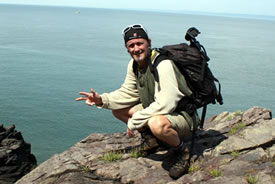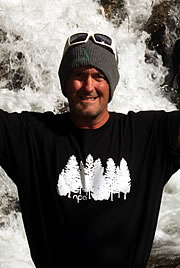10 items to pack when exploring Canada's protected lands

Greg Girard with his day pack in Nova Scotia (Photo courtesy Canada eh Travel & Adventure)
Imagine Canada's protected ecosystems as a very large fine art gallery with nature's works on public display 24/7.
Visitors to an art gallery follow a set of unwritten rules based on a mutual respect between the works of art, the patrons and the gallery itself. In an art gallery there is no foul language. There is no vandalism. No littering...in fact...many pack out what they pack in. And everyone prepares for the event and dresses appropriately. The same principles and respect apply to nature.
Showing respect for our protected lands and conservation areas when exploring starts with good preparation. Nature is, on most occasions, beautiful and comforting; however, nature can get real nasty in a hurry when one does not prepare for the unexpected and expected.
Preparation starts with the items you decide to pack with you on your day hike. We, the "eh Canada Travel & Adventure Team," have gone on thousands of day hikes as we research Canada for our tourism and adventure website and blog. Here is our list of items we take along when exploring the outdoors in Canada.
And remember...Respect for nature starts with preparation.
1. Day pack
You're pretty much asking for trouble if you do not have the right equipment for transporting items while exploring.
2. Technology
This can include camera, video camera and binoculars. Documenting adventures with photos and videos seems a whole lot smarter than storing memories in our short-term mental photo gallery.
3. Bug spray
We have explored with bug spray and without it (on one trip we found out too late the canister was empty. Ouch!). Our advice: get bug spray! Black flies and mosquitoes can quickly turn a great adventure into an itch-fest and/or fly swatting/waving exercise.
4. Bear spray
Knock on wood! We have never had to use ours, but it only takes one time for things to go bad when a bear likes you too much. Luckily for us all our bear encounters have been through a camera lens.
5. Hat (Toque) & Sunglasses
Weather can change on a dime. Skies can change quickly from sunshine blue to cloudy whites... so why put yourself in a dangerous situation? Bring a hat (and a toque if you are overly Canadian like us), sunglasses and sunscreen too.
6. Whistle
If trouble for any reason creeps into your adventure, a whistle (or a flare) could save your life.
7. Liquids & snacks
Some say performance is impaired when an individual is dehydrated by as little as two per cent of their body weight. Losses in excess of five per cent of body weight can decrease by about 35 per cent. Yikes! Without water your judgement is impaired, which is not a good thing when exploring in the wilderness. Don't be silly — bring water and some snacks.
8. Lighter & first aid kit
Often fire is life when it comes to survival for more than one day under emergency circumstances. A simple lighter could make the world of difference when your life is on the line. A fire alerts emergency crews, keeps wildlife at bay and provides warmth during cold nights. We store a lighter in our waterproof first aid kit.
9. Rain gear
Here's the beauty about rain gear: it is also wind gear, it packs light and does not take a lot of room in a day pack. Why play cat and mouse and taunt and dare Mother Nature when you know she will win every time if she decides to throw a storm or high winds your way. It's simple — layer your clothing for changing temperatures and have rain gear ready if need be.
10. Map/GPS/compass
This just makes common sense.
Our honourable mention: TP
That's right, toilet paper. Sometimes nature calls on us at inappropriate moments. Worse yet, sometimes outhouses (pit toilets) in the wilderness do not have TP on hand. Bring your own TP. You will be glad you did.


